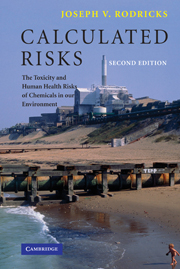Book contents
- Frontmatter
- Contents
- Preface to the first edition
- Preface to the second edition
- List of abbreviations
- Prologue
- 1 Chemicals and chemical exposures
- 2 From exposure to dose
- 3 From dose to toxic response
- 4 Toxic agents and their targets
- 5 Carcinogens
- 6 Identifying carcinogens
- 7 Risk assessment I: some concepts and principles
- 8 Risk assessment II: applications
- 9 Risk assessment III: new approaches, new problems
- 10 Risk assessment IV: the courtroom
- 11 The management of risk
- 12 A look ahead
- Sources and recommended reading
- Index
Preface to the second edition
Published online by Cambridge University Press: 25 August 2009
- Frontmatter
- Contents
- Preface to the first edition
- Preface to the second edition
- List of abbreviations
- Prologue
- 1 Chemicals and chemical exposures
- 2 From exposure to dose
- 3 From dose to toxic response
- 4 Toxic agents and their targets
- 5 Carcinogens
- 6 Identifying carcinogens
- 7 Risk assessment I: some concepts and principles
- 8 Risk assessment II: applications
- 9 Risk assessment III: new approaches, new problems
- 10 Risk assessment IV: the courtroom
- 11 The management of risk
- 12 A look ahead
- Sources and recommended reading
- Index
Summary
The central topics of this book have, since its publication in 1992, become permanent occupants of the public health agendas of governments everywhere. The imposition of controls on the production, uses, and environmental releases of chemical products, by-products, and environmental pollutants, whatever their sources, has become the ambition of most societies, and many now claim to rely upon risk assessments to guide their decisions about the necessity for, and extent of, such controls. Indeed, the risk assessment framework sketched out in the first edition, and given far more extensive treatment in this one, has come to be seen as a most powerful tool for evaluating and putting into useful form the complex, diverse, often inconsistent, and always incomplete scientific information and knowledge we have been able to accumulate about the health hazards and risks all chemicals pose if exposures become excessive. So in this edition the reader will be provided with a broader and deeper look at risk assessment as it continues to evolve as a scientific enterprise, and in its role as the bridge between basic and applied research and the many forms of decision-making aimed at risk reduction. Chapters dealing with the early evolution of the risk assessment framework and the several principles and concepts that gave rise to its structure, the ways in which relevant scientific data and knowledge are put to use within that framework, and some of the new challenges risk assessment faces, are almost wholly new in this edition.
- Type
- Chapter
- Information
- Calculated RisksThe Toxicity and Human Health Risks of Chemicals in our Environment, pp. xiii - xvPublisher: Cambridge University PressPrint publication year: 2006



